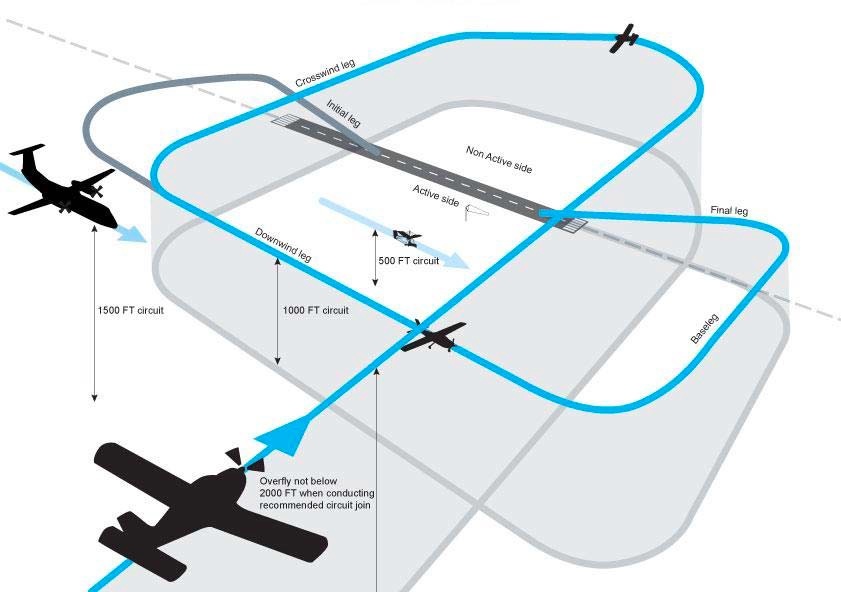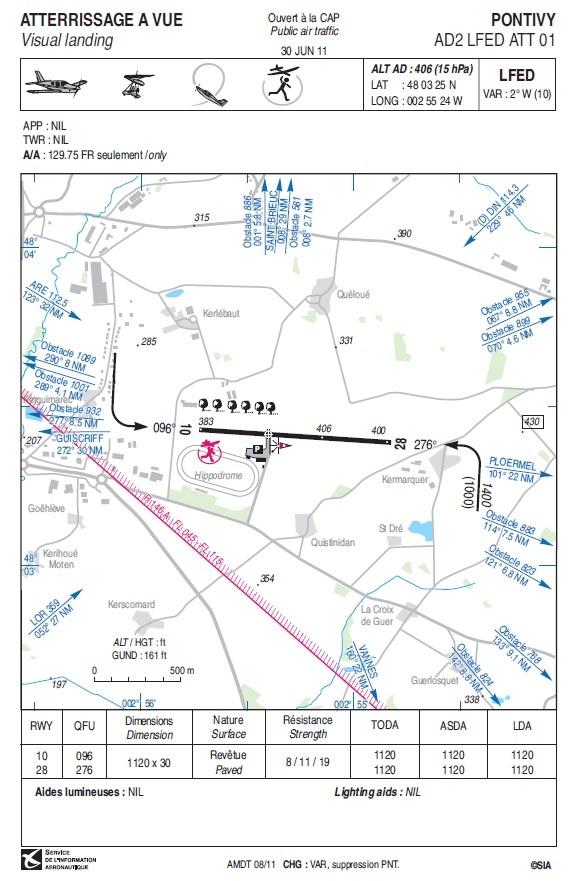This is a picture of the overhead join. Looks like a lot of turns, a lot of noise, a lot of potential confusion between reported and actual positions… The guy I suddenly had in front of me in my lesson actually wanted to do this, and ended up sinking into the active side downwind leg. Guess there is a lot of potential for errors…

I think the overhead join has no advantage over the conventional one safety wise plus it creates much more unnecessary noise for the people on the ground in the vicinity of an airfield.
What do you mean by a “conventional one”? I could be wrong, but I’m pretty sure that I remember that a “standard o/h join” is the one specified in ICAO docs.
There is a real danger here that everyone thinks that the one that they do in their home country, is the best option, because they know it best. In reality, you’re probably better off tailering your join to the circumstances.
1. If no presence at the airfield, then an O/H join is a good way of finding out that most suitable runway and positioning in with potential non-radio traffic.
2. If an air to ground (radio) is present, but who won’t or can’t say what the wind/runway in use is, then an o/h join is useful.
3. If you can find out the runway in use, then other options open up, such as downwind join, crosswind, base leg join; even a straight in join depending on the traffic levels.
4. If someone else is joining, then probably a good idea to do the same join at them (if they are first) as it keeps everyone doing the same thing.
5. If the airport specifies a specific type of join, then best to use that, as it’s what everyone else will be expecting you to do and what they will be wathing out for.
6. If ATC, then follow their instructions and they shoudn’t insist on an o/h, but rather the most expedient join.
Personally I think many of the posts miss the point.
As someone commented when you first learn it is the simplest way to join and I think this is where is all started. I agree it is the simplest.
It gives a new pilot time to orientate and much great chance of joining the circuit in the correct position with time in the circuit to complete all the landing checks and speed constraints. It also provides a controlled flow of traffic into the circuit all descending and joining in roughly the same position.
I agree it can cause conflicts and at first blush traffic all joining in the same position might not seem ideal. However inevitably it is a compromise. In the alternative how often how we heard and seen AT and pilots varioulsy joining the circuit in all sorts of different positions and with all sorts of ideas as to what constitutes downwind, base and crosswind, never mind joining on the wrong side and going the wrong way because they have not had time to orientate themselves with reference to the active runway. I think this introduces more risk.
However, if everyone carried GPS and if everyone knew how to show the extended centreline on their GPS then I think the overhead join would have a much reduced benefit to novice pilots (and others who have always had trouble joining circuits).
The “problems” are less at airfields with a single runway, but at airfileds with three runways, and where they are prepared and do use two of them at the same time you will see all of these scenarios in the same hour, never mind in the same day if it is busy. For that reason I would rather worry about spotting aircraft descending from the overhead than an aircraft coming towards me at the same height thinking he was flying the downwind (but in th eopposite direction)!
PS with every respect to the previous post yes it may looking confusing but the point is think how much more time it gives you to orientate – after all you are VMC of course so it gives you ample time to see the runway see the numbers make certain you are about to go around the circuit in the correct direction and join the circuit in the correct place – and if you are not certain, time to do something about it. On the other hand if you decide to join on any of the circuit legs effectively you get one go at it so you had really better get it right.
dublinpilot wrote:
I could be wrong, but I’m pretty sure that I remember that a “standard o/h join” is the one specified in ICAO docs.
Not exactly. There is a strange figure in previous versions ICAO DOC 4444 (for example see page 81 from here: http://www.gcaa.com.gh/extweb/images/stories/ais/icaodoc4444.pdf ). This looks remotely similar to an overhead join, but it isn’t. There is no crossing over the airfield, it is some kind of “deadside join” that I have never seen in real life.
In later versions of DOC 4444 the figure has been removed.
Fuji_Abound wrote:
I agree it is the simplest.
Obviously “simple” has a different meaning for different people  One wonders why from all 152 states on this planet only one has implemented this “simplest” way of joining a traffic circuit…
One wonders why from all 152 states on this planet only one has implemented this “simplest” way of joining a traffic circuit…
Personally, for me the French way of joining circuits is the simplest, here is one of many many similar charts:

Excuse me for finding the question a bit queer – of course the overhead is dangerous, anything one does flying carries dangers. As does all else we do, by the way. If the question was meant like “is the OHJ particularly dangerous” : I don’t see why it should. What is dangerous is all and sundry flying their own approach. The one safe formula is that the aerodrome defines and publishes how to fly the approach, and that everybody adheres to that. It doesn’t get any easier.
Obviously “simple” has a different meaning for different people One wonders why from all 152 states on this planet only one has implemented this “simplest” way of joining a traffic circuit…
Personally, for me the French way of joining circuits is the simplest, here is one of many many similar charts:
 yes, a very good point.
yes, a very good point.
I base my conclusion only on seeing how pilots get on with the different joins and which seem to result more often in “problems”. Of course that is hardly scientific, but equally the fact that 152 other states have adopted a different approach doesnt necessarily mean ours isnt the best! I seem to recall in SA the last time I flew there the overhead join at uncontrolled airfields never mind being recommended was mandatory (by law)?
I find the OHJ works fine for me and I use it when there is no one on the radio. When there is no one on the unicom the overhead is useful for determining wind direction and runway activity and status. Occasionally someone lands downwind or at a closed airfield because he had not seen the X on the runway or in the box – he would probably have seen that from overhead. Also I find my students rarely get lost after joining the circuit to an unfamiliar airfield from overhead, whereas that happens, I think, more often when joining the circuit more directly.
Safety wise I think the OHJ goes both ways. As someone said, the maneuvering is arguably complicated, and arriving pilots may not fly the OHJ in exactly the same way. But you get to see the runway and its traffic better from overhead. A common problem I often see with my students is that they have not finished descending to circuit altitude when joining downwind – that is a hazard specific to the OHJ.
I would also say, reference Euroflyer’s diagram above, that if that was all people were flying, there would be no point in the OHJ – because all you are achieving is flying a longer route to the runway.
All that is left in favour of the OHJ is that it gives you a chance to eyeball the windsock and, of course, whoops, nearly forgot, the institution which is the cornerstone of PPL training: the WW1 signals square! 
The OHJ is used to “get people out of the way” and leave them orbiting in the overhead at 2000ft AAL until such time as they can descend into the circuit.
That portion (orbiting over and over) is the bad bit from the collision POV.
Peter wrote:
I would also say, reference Euroflyer’s diagram above, that if that was all people were flying, there would be no point in the OHJ – because all you are achieving is flying a longer route to the runway.All that is left in favour of the OHJ is that it gives you a chance to eyeball the windsock and, of course, whoops, nearly forgot, the institution which is the cornerstone of PPL training: the WW1 signals square!
No, I think as a number have suggested it helps pilots to orientate.
I appreciate some may disagee, but equally that is a commonly held view.
I would add that when you have been flying for some while (and I suspect many forum attract the more “active” pilots) it is easy to forget those times you managed to “mess up” a join when you had far less experience.
Fuji_Abound wrote:
I appreciate some may disagee, but equally that is a commonly held view.
Again: “Commonly” in one country only (or maybe, as someone wrote, with South Africa a second one). Students and beginners throughout the rest of the world obviously have not much difficulty orienting themselves during a level join. I still fly with students regularly and never felt there was a need of an “orientation orbit” 2000ft above the airfield. But I agree that when operating from an untowered airfield (which does not exist in my part of the world) a procedure like an overhead join might be a smart thing to do.